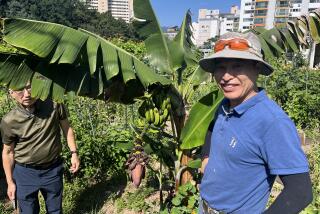GARDENING : Leave It to Nandina--Colors to Fall for All Winter
- Share via
Fall brings joy to gardeners who relish the season for planting or rejuvenating a garden. It can also brings nostalgia for the vibrant red, ocher or yellow leaves now dropping from trees in colder parts of North America.
But local color buffs need look only to Nandina domestica for exciting foliage pigmentation right in their own back yards. Commonly called “Heavenly Bamboo,” Nandina is not a true bamboo (it belongs to the barberry family), but fans may term the dazzling red or magenta leaf colors divine.
“I think it’s one of the Top 10 garden plants,” said Lloyd Tanaka, owner of Tanaka Nursery in Yorba Linda. “It’s a striking accent plant, not fussy about its growing conditions, and is easy to maintain.”
Native to China and Japan, Nandina grows widely there and is a cherished plant in Chinese and Japanese gardens. Plantings and landscape materials in both countries are valued for their beauty and symbolism. To the Japanese, Nandina symbolizes clear air and the gift of purification. Although that symbol is appropriate for Southern California, local designers value Nandina for its practical uses.
Nandina domestica can grow up to eight feet. The airy, graceful shrub resembles bamboo because of its lightly branched, cane-like stems and delicate foliage. Small white flowers are produced in summer, but the delicate-looking shrub is chiefly valued for its brilliant foliage and scarlet berries that remain on until April. The shrub is frequently used in mass plantings for vibrant splashes of fall and winter color.
Nandina’s popularity is increasing, and hybridizers are responding by introducing new varieties. Several grow especially well in this climate.
Nandina domestica ‘Nana Purpurea,’ is commonly called “Dwarf Sacred Bamboo.” This compact, dense shrub grows only to a mounded form about one foot high and two feet wide. Its foliage has a reddish purple tinge in winter. It is useful in rock plantings or containers as well as mass border plantings.
Another relatively new variety, ‘Harbor Dwarf,’ is low-growing, spreads freely from rhizomes and can be used as a colorful ground cover.
‘Moon Bay’ and ‘Gulf Stream’ are two compact varieties introduced seven years ago. Both grow to three feet and have vivid fall foliage but lack flowers and berries.
*
Nandina is a plant that not only tolerates frost but even turns a more intense shade when temperatures drop below freezing.
Although Nandina can tolerate partial shade, the coloration is more pronounced in full sun. Versatile in any growing condition, Nandina responds better when given abundant water and some fertilizer during the year.
“It’s more lush and full with ample water, but the leaf coloration is more intense in dryer conditions,” Tanaka explained.
He calls it a “do-nothing plant” because it’s one of those valuable garden additions that requires little attention.
Domestica and ‘Nana Purpurea’ both produce flowers in large panicles of very small, star-shaped, fragrant white flowers in summer. But the real show begins in fall, when foliage starts to turn color.
Nandina is in its glory now. Intense leaf coloration remains through January or February, depending on temperatures. The varieties that form berries retain them until April, when they shrivel and become insignificant. Foliage in spring and summer turns green.
Unlike most shrubs, Nandina requires only light pruning for shaping, and the compact varieties that are slow growing need even less. “Domestica” is an upright grower, useful as an accent planting and dense enough for background screening.
“It’s a very good vertical accent plant that adds color without demanding a lot of maintenance,” said landscape architect Kathryn Rue of Fullerton.
She also noted that the easygoing plants aren’t temperamental if they’re shifted around in the garden.
“Sometimes I need to move a Nandina just a matter of a few feet to improve the overall design,” she said. “These plants that may have been planted years ago transplant very well. In nine out 10 cases they don’t suffer from shock, and the few that do recover very quickly.”
Rue suggests thinning canes and trimming to restrain growth to just two or three feet if the plant is used in a small space. She also recommends backlighting to create dramatic visual effects in the evening.
*
The rustling of Nandina in a breeze or wind also brings a pleasant sound to the garden. Because the leaves are relatively small, the leaves that drop or blow in the wind aren’t a messy nuisance and are quick to decompose.
Nandina can be grown in tubs or containers, outdoors and indoors, as long as plants receive plenty of light and aren’t exposed to warm, dry air currents.
A bonus for people who live in wilder areas is that deer and insects show little interest in the plant.
Occasionally, the plant can become chlorotic in alkaline soil. A supplemental dose of iron easily clears up the condition.
Nandina is available in most nurseries and garden centers in one or five-gallon containers.






